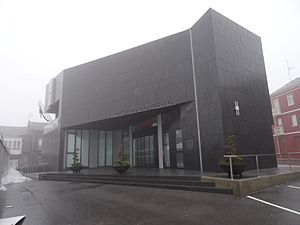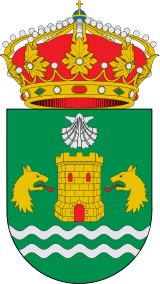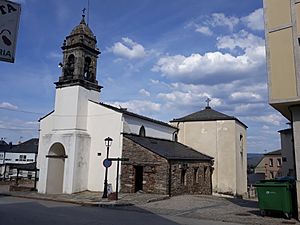A Fonsagrada facts for kids
A Fonsagrada is a town and a local government area in northwest Spain. It's located in the province of Lugo within the region of Galicia. The town is about 25 miles (40 km) east-north-east of Lugo city. In 2004, about 5,007 people lived there. A Fonsagrada sits high up, about 3,166 feet (965 meters) above sea level. It's on a ridge between two rivers, the Rodil and the Suarna. Long ago, it was a busy market for farm goods. People also made linen and a type of wool cloth called frieze for local trade.
The history of Fonsagrada is closely connected to the Camino de Santiago, a famous pilgrim route. One special path, called the Camino Primitivo (which means "the original path"), goes right through this area.
Contents
History of A Fonsagrada
A long time ago, A Fonsagrada was part of a larger area called the City Council of Burón. This area also included what is now Negueira de Muñiz. Later, Negueira de Muñiz became its own separate council. In 1943, the local government chose Benjamin Alvarez Fernandez to represent the towns of this province in the Spanish Courts.
The Original Pilgrim Path: Camino Primitivo
The "primitive way" is a part of the Camino de Santiago. This section stretches between Oviedo and Palas de Rei. It enters Galicia through A Fonsagrada. Along this path, you can find interesting old places. One example is the "New Royal Hospital of Santiago de Montouto." This building is now partly in ruins, but it used to be a place where pilgrims could rest and get help.
This hospital was built after an even older one, the "Old Royal Hospital of Santiago de Montouto." That first hospital was started by King Pedro I, also known as "The cruel." The hospital even gave its name to a nearby mountain range, which is called the "Serra do Hospital."
Fun Times: Carnivals and Festivals
A Fonsagrada and its nearby villages have special ways to celebrate carnival, also known as Antroido. During these festivals, the lights are turned off. People then light torches, which are called "fachas" in the local Galician language. Everyone goes on a special walk or pilgrimage with their torches.
There's also the "Feria de septiembre," or "September Fair." This used to be one of the biggest and oldest livestock fairs in the whole province of Lugo. Farmers would bring their animals to trade. However, over time, many small farms in the villages closed down. Because of this, the fair became less important in the late 1900s.
Now, the "Feria del emigrantes," or "Fair of Emigrants," is very important. It happens in early or mid-August. This fair is a special reunion for people who left the area to live elsewhere. They come back for vacations to visit their families and friends.
Another important day is the Day of Galicia, which is on July 25. This celebration takes place near the "New Royal Hospital of Santiago de Montouto." It's held in a small chapel that was recently built. People have a procession there to honor St. James.
Nature and Plants
Most of the region around A Fonsagrada is mountainous. This means the types of plants that grow there are somewhat limited. The area has plants typical of Atlantic mountains. It also has some plants that are usually found in Mediterranean areas. You won't find any oak trees or orange trees growing here.
Pine trees are common now because many were planted again. However, the original type of black pine tree that once grew here is thought to be gone from the region.
Wildlife
The wildlife in this area includes a rare animal called the Kerry slug.
See also
 In Spanish: Fonsagrada para niños
In Spanish: Fonsagrada para niños





